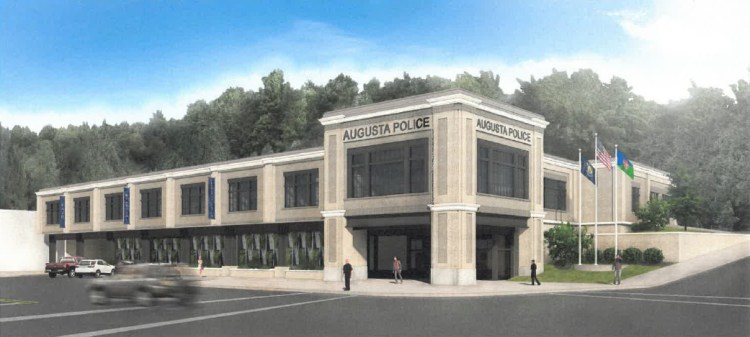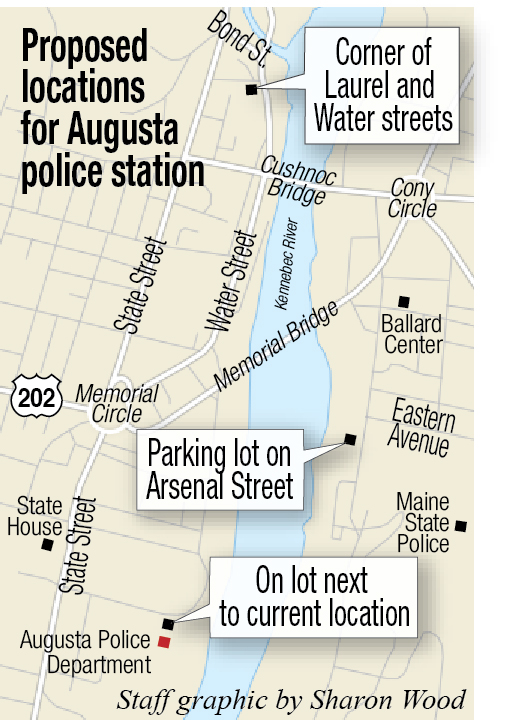AUGUSTA — A proposed new Augusta Police station to replace the worn out current station is expected to cost between $17.3 and $21.5 million, depending on which of three sites city councilors settle upon.
The cheapest option would be on Union Street next to the existing station; the most expensive, a downtown site at the corner of Water and Laurel streets.
Some officials, notably Mayor David Rollins, feel the downtown site’s additional costs — which are expected to include demolition of the substantial brick-and-concrete building on the site now and the challenges of building on a confined site — would be outweighed by the potential economic and community development benefits of putting the new station in what they say is a blighted part of downtown in need of a boost. Rollins suggested a new police station could spur other development in the northern end of downtown.
“The cheaper way to go may be the more expensive, in the long run,” he said at a City Council meeting Thursday. “If we can take on the big project, I hope, I think that creates a big buzz for Augusta. We’re going to build a police station, or we’re going to do something really big.
“I think we’re going to make a stir if we can do it,” Rollins added. “But we’ve got to be able to get there, on behalf of taxpayers.”
The proposed project would require bond funding which, in turn, would have to go to Augusta voters in a referendum question. City Manager William Bridgeo said if councilors vote to move ahead with the project it could go to city voters in March 2020. If they approve it then, ground could be broken for the project in the early spring of 2021.
With the City Council currently depleted and down to six members, Bridgeo noted councilors won’t vote on any proposed borrowing for it until January 2020 when the council should be back at full, nine-member strength when newly elected councilors take office.
But first councilors need to pick a spot where the station would be built.
On Thursday, they heard summaries of what would be involved in building a station at either of three sites selected by city staff, with suggestions from councilors, as potentially good spots for a new police station.
They also heard what each could cost to build if work starts in 2021, including all project costs and more than $1 million in contingency funds for each, as determined by a consultant.

A rendering of what a proposed Augusta Police station could look like if it was built on Union Street. The rendering was shown as part of a presentation by a pair of firms, Artifex Architects and Engineers and Manns Woodward Studios. Image courtesy of the City of Augusta
The Union Street site, next to the current station, would be the cheapest, at $17.3 million.
The Arsenal Street site, on a parking lot now owned by the owners of the nearby Ballard Center complex in the old hospital building, would cost about $19.8 million.
And the downtown site, known as the Apgar site for the largest building on it, which would be demolished to make way for a new station, would be the most costly, at $21.5 million.
The costs for the three sites varied in large part due to the potential difference in acquisition costs for each and in the cost of building a police station on them. Each would have a station with about 24,000 square feet of working space for police.
Rob Manns, vice president of Manns Woodward Studios — a Maryland firm that specializes in public safety buildings, told councilors the downtown Apgar site has challenges, all of which he said can be overcome. They include needing to “harden” the building with thicker walls because it wouldn’t have space for a 50-foot setback from the road to provide a standoff area in case someone tried to attack the building, limited space, and the steepness of the grade on the back of the property. The proposal for the site would be two stories to maximize the space, with a parking garage on the lower level accessible from Water Street and most other functions on the upper level, which would be accessible off Laurel Street.
Of the three sites, Manns said, the downtown location would be the most visible to the public. He said that could help instill confidence in people visiting that area, but said generally police stations aren’t considered destinations or economic catalysts.
The Arsenal Street site would need to be built on top of a raised foundation since the current parking lot is below the grade of the street. The raised structure could also, if desired, serve as a parking garage.
The flat Union Street site would require the least amount of preparation for a new building, according to the presentation from Manns and Ellen Angel, co-owner of Artifex Architects and Engineers, a firm hired to assist the city in designing its next police station.
The city already owns the Union Street site, but would have to acquire either of the other two spots. Bridgeo said he’s talked to Kevin Mattson, principal of the company which owns the Ballard Center and Arsenal Street parking lot being considered for a new police station location, and he expressed willingness to negotiate.
Bridgeo said one issue with that site could be that the parking lot where the station would be built was part of the parking plan when the Ballard Center project was approved by the Planning Board, meaning the 200 or so parking spaces there may need to be replaced with other spots, unless some sort of waiver of parking requirements were to be approved for the Ballard Center.
The Apgar building, by far the largest building on the downtown site, is owned by Rockland businessman Rick Rockwell. Bridgeo said Rockwell gave the city permission to go on the property to conduct test borings and would likely be open to negotiations to sell it.
The estimated budget for the Apgar site includes $345,000 for acquisition of the site, while the budget for the Arsenal Street site includes $630,000, though that figure does not include any funds to potentially compensate the owner for relocating parking spaces.
Angel said construction costs continue to rise, noting, if the station had been built in 2017 it could have cost about 40% less to construct.
Send questions/comments to the editors.





Success. Please wait for the page to reload. If the page does not reload within 5 seconds, please refresh the page.
Enter your email and password to access comments.
Hi, to comment on stories you must . This profile is in addition to your subscription and website login.
Already have a commenting profile? .
Invalid username/password.
Please check your email to confirm and complete your registration.
Only subscribers are eligible to post comments. Please subscribe or login first for digital access. Here’s why.
Use the form below to reset your password. When you've submitted your account email, we will send an email with a reset code.